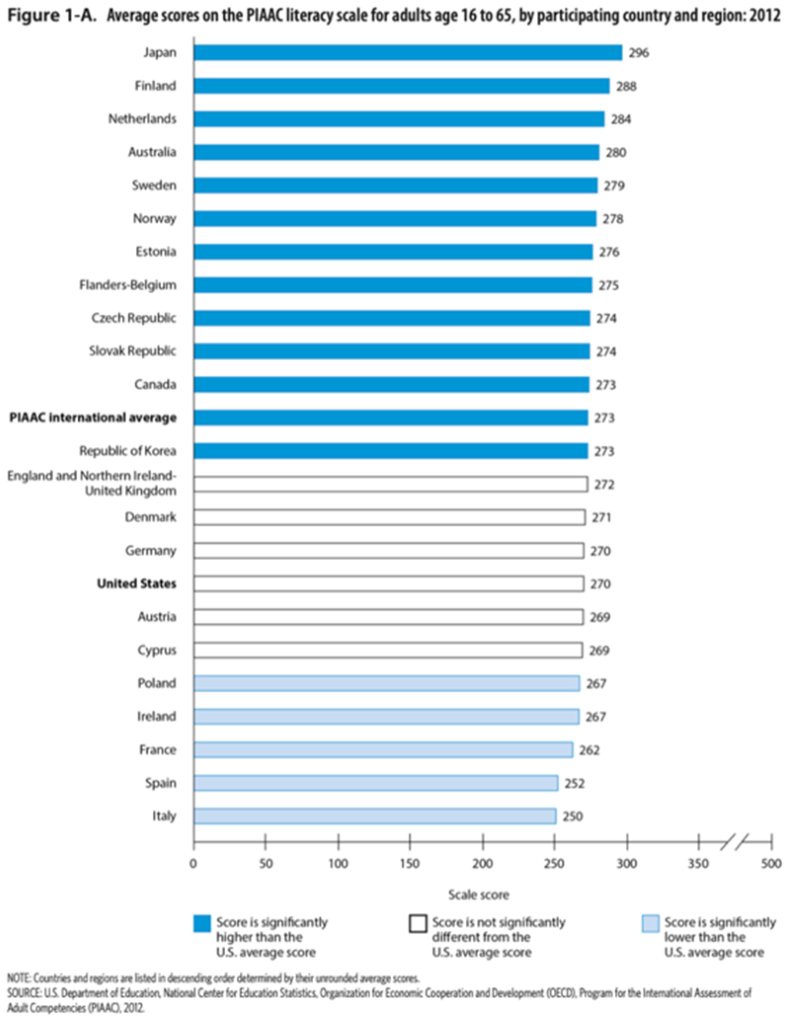Just 2% of global adults read at top level
Little confession here: I’m a geek. While you’re out partying on Saturday night, I’m cuddled up with a warm study.

The latest object of my affection is the 2012 edition of the PIAAC, or Program for the International Assessment of Adult Competencies. (The name itself could not be understood by most of the people it surveyed!) [1]
The PIAAC is a huge, statistically significant study of adult literacy in developed countries. Every 10 years, the OECD (that’s Organization for Economic Cooperation and Development to us mortals) looks at the literacy skills of adults between 16 and 65.
The average American reads at the 7th- to 8th-grade level.
— The Literacy Project [2]
In the most recent study, what the researchers found was disheartening …
4% are nonliterate.
Some 4% of Americans (global literacy rate: 3%) have Below Level 1 literacy. That means they are nonliterate. They can’t read well enough to perform activities of daily living in a modern society — let alone to take a literacy test.

Most of them can locate a single piece of information in familiar copy. But most of them cannot review a simple table identifying three candidates and the number of votes they received to identify which candidate earned the fewest votes.
14% have below-basic literacy levels.
14% of Americans (global literacy rate: 12%) have level 1 literacy. That means they can read and write at the below-basic level.
Most of them can identify which candidate earned the fewest votes from a simple table identifying three candidates and the number of votes they received. Most cannot count the number of countries in which the generic drug market accounts for 10% or more of drug sales from two paragraphs and a chart of generic drug use in 15 countries.

34% have basic literacy levels.
Half of U.S. adults can’t read a book written at the 8th-grade level.
— Organization for Economic Cooperation and Development [3]
About one-third of Americans (global literacy rate: 34%) have Level 2 literacy. That means they have the ability to read and write at a basic level.
Most can count the number of countries in which the generic drug market accounts for 10% or more of drug sales from two paragraphs and a chart of generic drug use in 15 countries. But most cannot identify the link leading to the organization’s phone number from a website with several links, including “contact us” and “FAQ.”

Note that at this point, we have reached more than half of your audience members.

The people who manage this study are careful not to assign grade levels to these groups, but we can do a little correlating. Here’s what we know:
- Half of U.S. adults can’t read a book written at the 8th-grade level, according to the OECD. [4]
- The average American reads at the 7th- to 8th-grade level, according to The Literacy Project. [5]
- Medical information for the public should be written at no higher than an eighth-grade reading level, according to the American Medical Association, National Institutes of Health and Centers for Disease Control and Prevention

So let’s estimate that the midline here is the break between 7th- and 8th-grade reading levels. That means half of U.S. adults read at the 7th-grade level and below, and half read at the 8th-grade level and above.
36% have intermediate literacy levels.
More than one-third of Americans (global literacy rate: 39%) have Level 3 literacy. That means they can read and write at an intermediate level.

Most can identify the link leading to the organization’s phone number from a website with several links, including “contact us” and “FAQ.” But most cannot click to the second page of search results from a library website to identify the author of a book called Ecomyth.
12% have proficient literacy levels.
Now we reach the cognitively elite: 12% of Americans (global literacy rate: 12%) have what is now called Level 4/5 literacy. At Level 4, that means they can read and write at a proficient level.
Most can click to the second page of search results from a library website to identify the author of a book called Ecomyth. But most cannot review search results from a library website to identify a book suggesting that the claims made both for and against genetically modified foods are unreliable.
If you write for these proficient readers, you’ll miss 88% of adults in the United States.

2% have high literacy levels.
This year, for the first time ever, PIAAC combined the fourth and fifth literacy levels. That’s because there were no longer enough people at the highest level to count.

“Across all countries, only 2 percent of adults performed at Level 5 on many of the variables in the literacy and numeracy scales,” researchers report. Because of the low number, these are included among the 12% in Level 4/5.
This is the only group that can identify from search results a book suggesting that the claims made both for and against genetically modified foods are unreliable.
Write for these folks, and you’ll miss 98% of your readers!
U.S. literary average: below-basic
Put it all together, and what do you get? Our average literacy score of 270 (global literacy rate: 273) out of 500 puts U.S. adults at Level 2, or below-basic, literacy.
U.S. literacy averages below basicResults of the 2013 PIAAC |
|||
| Literacy level/score | Percentage of U.S. adults 16+ | Skills | Sample task |
| Below level 1 (Nonliterate) 0-225 |
4% | Locate a single piece of information in familiar copy. | Locate a single piece of information in familiar copy |
| Level 1 Below basic 226-275 |
14% | Read relatively short digital, print or mixed copy to locate a single piece of information. | Review a simple table identifying three candidates and the number of votes they received to identify which candidate earned the fewest votes |
| Level 2 Basic 276-325 |
34% | Find information that may require low-level paraphrasing and drawing low-level inferences. | Review two paragraphs and a chart of generic medicine usage in 15 countries to count the number of countries in which the generic drug market accounts for 10% or more of drug sales |
| Level 3 Intermediate 326-375 |
36% | Identify, interpret or evaluate one or more pieces of information that require inference. | Review a website with several links, including “contact us” and “FAQ” and identify the link leading to the organization’s phone number |
| Level 4 Proficient 376-500 |
10% | Perform multiple-step operations to integrate, interpret or synthesize information from complex texts, which may require complex inferences. | Click to the second page of search results from a library website to identify the author of a book called Ecomyth. |
| Level 5 | 2% | Integrate information across multiple dense texts; construct syntheses, ideas or points of view; or evaluate evidence-based arguments. | Identify from search results a book suggesting that the claims made both for and against genetically modified foods are unreliable |
That places the U.S. overall literacy score at lower than the international average. But note that Japan and Finland, at the top of the list, have nothing to brag about.
U.S. literacy averages below basic
Results of the 2013 PIAAC

In this environment, how well are we doing reaching these folks with our blog posts, intranet stories or email newsletters?
As George Bernard Shaw wrote:
“The problem with communication is the illusion that it has been accomplished.”
Learn more
- Reach all of your readers, even those with low literacy
- Readability helps everyone, even highly literate people
- Get more data from the National Center for Education Statistics
Get more information about national assessment, levels of literacy, the literacy gap, how literacy rates vary among high school students and those ages 15 and under, and English literacy among foreign-born adults from the National Center for Education Statistics, part of the U.S. Department of Education.
[1] “Literacy, Numeracy, and Problem Solving in Technology-Rich Environments Among U.S. Adults: Results from the Program for the International Assessment of Adult Competencies 2012,” Program for the International Assessment of Adult Competencies, or PIAAC
[2] Lisa Marchand, “What is readability and why should content editors care about it?” Center for Plain Language, March 22, 2017
[3] Valerie Strauss, “Hiding in plain sight: The adult literacy crisis,” Washington Post, Nov. 1, 2016
